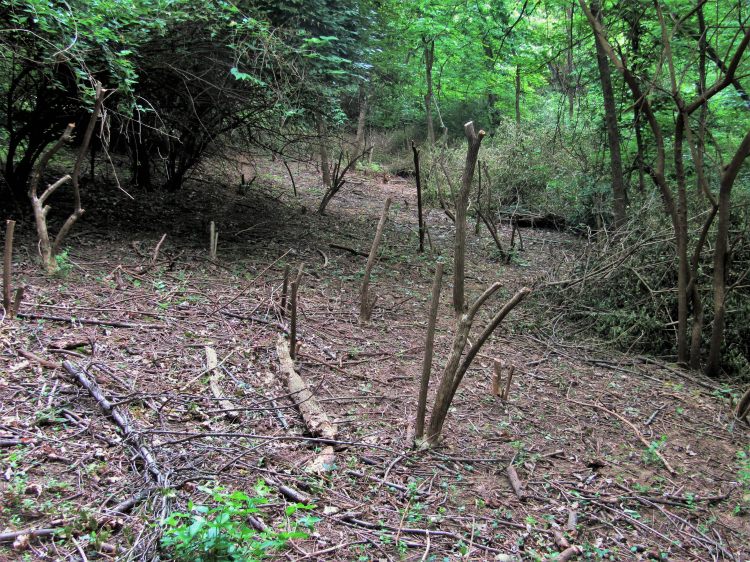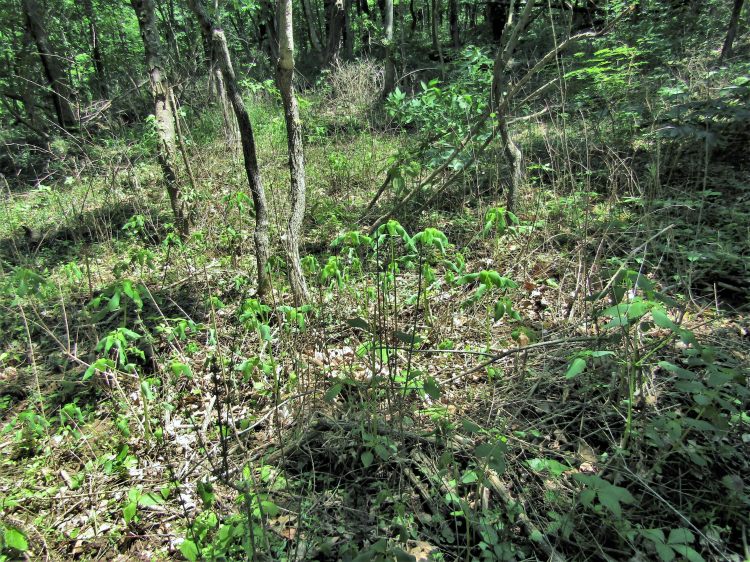
Working on invasive plants is like managing the behavior of a defiant two year old. One must be consistent and firm in resolve, day after day, for at least sixteen years. Let up for even a little while and you lose a lot of ground. Of course, most two year olds grow up to be some sort of adult, but invasive plants never go away.
Why is it so hard? Beargrass Creek SNP is a particularly challenging property because of its land use history. After the Revolutionary war the property was named “Fox Hill” by the prominant Prather family, whose servants and slaves planted orchards, built stone walls, cut trees for lumber, and tended the crops, livestock and fine horses. Intensive land use continued till mid 20th century, just about the time plants like Bush Honeysuckle were unleashed into the landscape. The timing couldn’t have been worse; another damaged, vulnerable piece of land was quickly reclaimed by fast growing non-native plants just doing their job.

In this typical urban forest, invasive shrubs and vines now dominate much of the understory, and their seeds alone inhabit the “seed bank” (all seeds resting in the soil). Once invasive plant removal has begun the process needs to continue intensively, or it’s a waste of time.

As soon the forest floor is released from the deep shade of Bush Honeysuckle, a new growth cycle begins. Seeds that have been languishing are now able to germinate, and like the contents of Pandora’s fabled box, a whole cohort of “secondary” invasive plants spring up that were not a problem before. These include Garlic Mustard, Japanese Stiltgrass (makes a monoculture on the forest floor), Japanese Honeysuckle and Asiatic Bittersweet (the sapling tree stranglers), Porcelainberry (a grapevine relative that behaves like a mini-Kudzu) and others.

Three years ago all invasive plants on this site (pic above) were cut and stump treated with herbicide. The lush new growth suggests that recovery is going well; however it’s almost entirely composed of the original invasives and several new ones.
This is what we didn’t understand in the early years of invasive plant work – you can’t just go out every now and then, cut down an acre of Bush honeysuckle and go home thinking you’ve made things better. Though we painted herbicide on the Honeysuckle cut stumps, the seeds in the soil waiting to grow were the real problem. We cut and pulled and cut and pulled for years, before we realized there was no keeping up; invasive plants grew faster than we could work.

What to do? A more intensive technique was required – herbicide foliar spraying. This involves spraying a diluted mix of glyphosate (generic Roundup) on the gazillions of new invasives that pop up on any recently cleared site. I had never used herbicides prior to getting an applicator’s license – now I walk around with a backpack sprayer, killing young Bush Honeysuckle, Privet, and Wintercreeper plants. I would not describe this as fun. But to see Spicebush Swallowtail butterflies flitting through groves of young Spicebush, where only Bush Honeysuckle grew before, makes it worthwhile.

The pic above is an example of a site till recently overrun by thickets of Privet; it was foliar sprayed last fall (dead grey stems). Jewelweed and Virginia Wild Rye are rapidly covering the ground – it’s always fascinating to see what begins to “revive” on these sites. What makes it tricky, is that foliar spraying may still be needed even as native plants are recovering on a site. It’s possible to aim the sprayer wand with almost surgical precision, but maintaining such a high level of focus is tiring and time consuming.

Because I like my glass half full, focusing on the “revival” end of the process is really my cup of tea. (How’s that for mixing metaphors?) In the pic above, an intensively managed site near post #18 shows the beginnings of sustainability – many young Spicebush shrubs, Lindera benzoin, cover the ground. Though visitors to the preserve notice and comment on the decreasing amount of Bush Honeysuckle, it’s the revival of native shrubs that’s important.

This lovely “parklike” landscape is in recovery – five years ago it was dominated by Bush Honeysuckle, followed by Privet, Wintercreeper, etc. The shrub layer is full of deer-proof young Spicebush and Pawpaw, the default plants of mesic midwest forests. Though herbicides were used, care was taken to avoid most damage to native plants. Because there’s partial sun here, and more on the way due to dying Ash trees, the openness will not last. Spicebush, in particular, can create a tall, shrubby habitat that will help prevent reinvasion by Bush Honeysuckle. In fact, the two plants are remarkably similar in form, mature size, and method of dispersal (red berries). So it’s easy to see how Bush Honeysuckle took over this understory niche.

The best hope for the future is to keep whittling down the invasive plant population to a level of yearly routine maintenance, with the guidance of a long-term management plan. But on much of the preserve we’re still nowhere near this happy state of things. So I’ll keep my backpack sprayer on my back, because I do love to see Spicebush Swallowtails.



Phyllis Fitzgerald
Such devotion! I am so proud of your progress!
LikeLiked by 1 person
oneforestfragment
Thanks Phyllis! Though I coordinate the work, we must thank the forest stewards, and countless volunteers – interns, high school and college students, scouts and more.
LikeLiked by 1 person
Elizabeth
Great pictorial view of the slow but steady progress. Sometimes we lose sight of the fact that we can make a difference. Thanks for all of your work and managerial dedication.
LikeLike
Anonymous
I liked your managed metaphorest too:)
LikeLike
oneforestfragment
And tnanks for that clever reply, Someone!
LikeLike
Anonymous
Roger that!
LikeLiked by 1 person
oneforestfragment
And thank-you Elizabeth for all your work , including strapping on that backpack sprayer!
LikeLike
Jim Sky
Any suggestions for a simple guide to common invasive vs. native plant species?
LikeLike
oneforestfragment
I found a good guide to common invasives
of this area:
Click to access Chapter%206%20KY%20Unwanted%20Plants.pdf
I don’t know of a comparative guide; there are just so many common native plants ,and it’s different from place to place.
LikeLike
Jim Sky
This is a really nice reference. Thank you.
LikeLike
Debbie
You and your team have made great strides, I see new things every time I visit, thanks
LikeLike
oneforestfragment
Thanks, Debbie! I hope new things keep showing up, except for new invasive plants.
LikeLike
conrad selle
The last photo looks like its from the seep area on the slope below #14 (more like 14.25) facing Joe Creason. Always amazing to see the exponential increase in light. Wish we had an exponential increase in volunteers to deal with the problems and the opportunities. Like treating winter creeper before its a carpet of doom stunts the restoration plants, or porcelain berry before it crawls up and over plants trees and everything. Living close to Cherokee my backyard gets a hefty dose of bad actors, made worse by a neighbor who thinks bush honeysuckle is an acceptable border.. LG&E has to trim it at utility customer’s expense every two years.It ought to be banned. But the diversity of the wild geraniums, physostegia, frostweed,spiderwort,orange milkweed and others keeps the backyard interesting.The 80 acres of the State Nature Preserve and contiguous properties under LNC management have great potential aready evident in the work so far.
LikeLiked by 1 person
oneforestfragment
And thanks for all your hard work to improve it! Yes, the photo is from the place you cut, probably doesn’t look that bare anymore.
LikeLike
tonytomeo
English ivy, giant reed, blue gum eucalyptus, pampas grass, Acacia dealbata, Scotch broom . . . . there is no end to the list of invasive exotic specie.
LikeLike
Deany C.
Thank you for the article and for the link. I am removing all of the Garlic Mustard from my backyard after reading that it poses a threat to butterflies. Also today we had our first box turtle visit since the start of the Nightingale MSD project, which is now complete. We were so excited to see the box turtle. Sadly, it was not one of the two box turtles that came around each year to see us. Hopefully we will start seeing box turtles come around. : ) I have planted fennel for the swallowtail, I will now check in to getting a spice bush. It is great to have you on nature’s side. : )
LikeLike